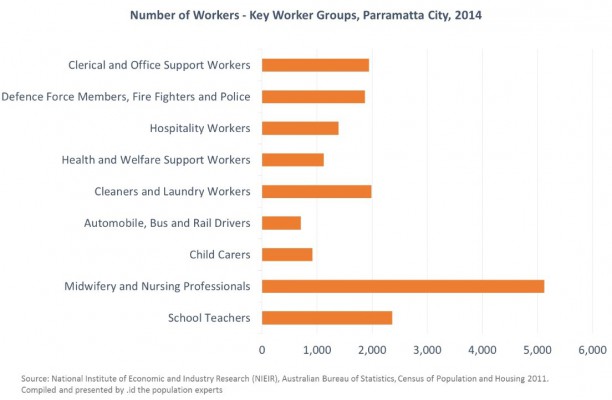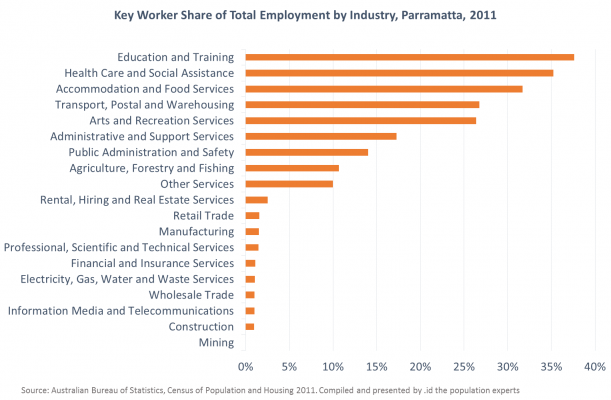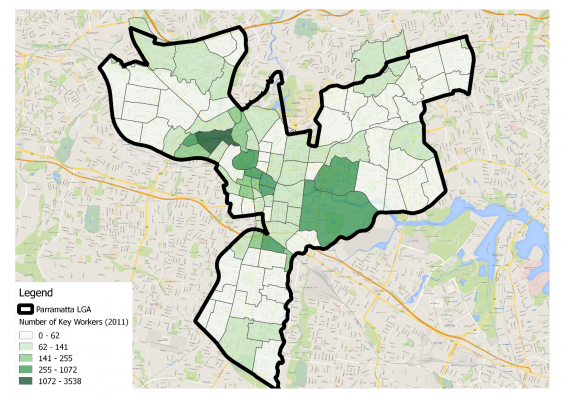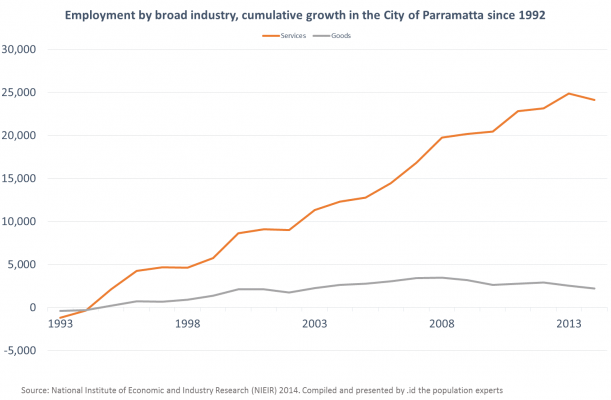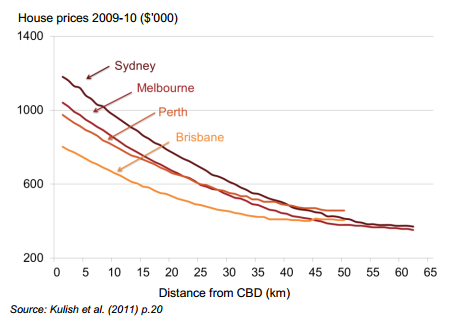BLOG
How housing affordability can play a role in economic development
How housing affordability can play a role in economic development
Housing affordability is typically considered a social issue and is given limited attention in many economic development strategies. Research by .id shows that if housing is no longer affordable for lower income workers or Key Workers such as teachers, nurses and cleaners, then this will have an impact on the productivity of a place because the local economy needs Key Workers to function.
This blog summarises our analysis of Key Workers in the City of Parramatta. This research points to the conclusion that there is now a need more than ever for Councils to develop urban renewal or housing strategies to combat housing affordability as a key pillar of economic development.
Case study: City of Parramatta – Key Worker analysis
Who are they?
For the purpose of this analysis we defined Key Workers as School teachers; Midwifery and nursing professionals; Defence force members, fire fighters and police; Health and welfare support workers; Hospitality workers; Child carers; Cleaners and laundry workers; and Automobile, bus and rail drivers. These groups were considered important to support the future growth of Parramatta’s service sector economy. Of course, this definition will change from location to location and will depend on the economic role and function of a region.
How important are Key Workers to the economy?
Well it depends on the location. In a place like the City of Parramatta, Key Workers play a valuable role in three key ways:
1. Contribution to total employment
In 2014, there were an estimated 17,360 Key Workers in the City of Parramatta. This is around 14.6% of all workers and around 97 workers for every 1,000 people in Parramatta. This level of employment is around the same size as the Public Administration and Safety Industry which is Parramatta’s second largest industry.
2. Industry concentration
In Parramatta, Key Workers account for a high share of total employment in Education and Training (38% of total), Health Care and Social Assistance (35%), Accommodation and Food Services (32%), Transport, Postal and Warehousing (27%) and Arts and Recreation Services (26%). This high share highlights the importance of Key Workers in supporting the output of key industries in Parramatta.
Take Health Care and Social Assistance for example. Based on Parramatta’s Economic Impact Model, If the number of hospital jobs increased by 100, then a further 54 jobs would be created as a result of industrial and consumption effects. This means that the increase in employment in a hospital will not only add to the value of that sector, but also to other industries related to the supply chain such as cleaning, laundry and food catering.
3. Clusters
The largest Key Worker group by far was Midwifery and Nursing Professionals (5,115 workers), due to Parramatta’s strong health care role. The map below illustrated that there is a Key Worker cluster in the Westmead Hospital precinct. The success of locations like these will be influenced by the level of Key Worker labour supply available.
Some demographics
To better understand Key Workers, we also prepared a demographic and socio-economic profile for each Key Worker group. Some of the key findings were:
- Key Workers have a lower median income ($953 per week) than all workers in the Parramatta City ($1,041 per week. They also have experienced slower income growth.
- There is a large degree of income diversity within key worker groups. This highlights the influence of career stage and different qualifications.
- 80% of key workers commute from outside Parramatta City. There appears to be a preference to live locally however, with 60% of key workers living within 10kms of Parramatta City.
Drivers of Key Worker growth
The economic role of Key Workers is set to become even more important in the City of Parramatta over the next 15 years. This will be due to strong forecast population growth, a younger demographic, and robust employment growth driven by service sector industries (e.g. health and education). Based on our employment projection model, we found that total Key Worker employment in Parramatta is projected to grow by between 3,900 to 5,100 workers by 2031. A large share of this growth is expected in three Key Worker groups: Midwifery and Nursing Professionals; Defence Force Members, Fire Fighters and Police; and School Teachers.
Of course the scale and nature of Key Worker growth will vary from one location to the next.
The costs of success
In Parramatta, the bulk of new job growth over the past two decades has been in service industries, with around 24,000 new jobs created since 1992. These jobs are diverse in nature and include doctors, nurses, teachers, researchers, accountants, consultants, software design and engineering. The ability to attract skills will be a key requirement for the Parramatta economy as it continues to transform towards more knowledge intensive activities.
The rapid expansion of the service sector and concentration of higher skilled jobs in certain locations has put pressure on housing stocks leading to rising housing costs. Parramatta previously enjoyed an economic advantage in housing and rental affordability compared to other locations in Greater Sydney. But this advantage has diminished in recent times. In 2010, Parramatta LGA’s house price was around 8% more affordable than the Greater Sydney median house price. By 2014, this cost advantage was only 2%.
What are some of the takeaways?
Without going into too much detail about the Parramatta conclusions, here are a few observations:
- The definition of Key Workers differs from one location to the next. An understanding of the economic role and function of an LGA is a useful first step.
- Key Workers play a valuable role in supporting growth of the Parramatta economy – Size, Industry Concentration and Clusters.
- Key Workers, and other lower income jobs, are at risk from escalating housing costs, particularly if housing supply is constrained.
- The research also highlights that a large share of Key Workers actually live outside of Parramatta, typically within 10 kms. This means that other locations have an important role in housing the Key Workers who work in the City of Parramatta.
We need to integrate economic development strategies with urban renewal strategies
On one hand a decrease in housing affordability is indicative of the success of an area, but on the other and it is also a threat to future levels of productivity. So what does this mean for other Councils and why should economic development strategies play a role? The chart below highlights the premium already being placed on housing close to major employment locations such as our CBDs.
If left unchecked, escalating house and rental prices across our cities and regions have the potential to push Key Workers further away from key employment nodes. This risk is even greater for Key Workers who already have lower incomes and face lower income growth. Without an adequate level of Key Worker labour supply that can afford to live close to work:
- local industry will face additional costs and have impacts on competitiveness (e.g. job retention, recruitment costs, etc).
- workers will face additional costs in the form of transport or housing, resulting in a fall of disposable income.
- workers may change their place of work to be closer to home, further reducing the labour force pool available.
This research shows that increasing housing affordability is one essential building block to increasing economic productivity. These observations point to the conclusion that sustainable economic growth needs to be underpinned by an urban renewal plan to grow housing stock. What should this urban renewal plan include? Successful places offer housing choice through increasing housing stock but also housing diversity. At .id, we refer to this as the 3 D’s:
- Diversity in locations
- Diversity in product types
- Diversity in price points
Increasing housing choice is the mark of a successful market economy and a fundamental strategy to improve the amenity and liveability of an area. Urban renewal can play an important role in creating the opportunity to work and live locally and maximise the potential benefits from agglomeration (i.e. from increasing labour force catchments).
It is also worth noting that addressing housing affordability also addresses inequality. And as we know from research published by National Economics (State of the Regions Report 2015-16), decreasing inequality increases economic productivity.
This means we need to integrate housing and economic development strategies. And this is why it is so important for economic development professionals to have access to tools like economy.id but also tools like forecast.id that allow you to identify what is driving population change in specific communities and forecasts how the population, age structure and household types will change between now and the next 20 years.
So next time you undertake an Economic Development Strategy, take time to analyse the economic need for more housing to support productivity. Or even better, get yourself involved in the next housing strategy and highlight the importance of housing from an economic perspective.
Here are some ideas to influence the conversation:
| Housing Strategy | Economic Outcomes |
|---|---|
| Increase housing affordability | To increase economic productivity. |
| Increase housing supply | To maximise the labour force pool. |
| Increase housing supply in multiple/specific locations | To support employment precincts and increase activity levels / viability of uses. |
| Lifting barriers to housing growth | To increase economic productivity |
| Improve public transport connections to major employment precincts | To reduce overall living costs and increase the labour force pool available. |
| Understanding housing need from key groups – e.g. nurses | To improve the competitiveness of a location and attract skills |
Rob Hall
Rob is driven by a desire to help shape communities for a better future. Trained as an economist, he has a unique twenty-year background in economics, demographics, statistics and strategic planning with a focus on understanding how economic forces influences local government areas across Australia. At .id, Rob provides Local Government with high-quality analysis and information tools, including specialised consulting services and tailored information products such as economy.id.

